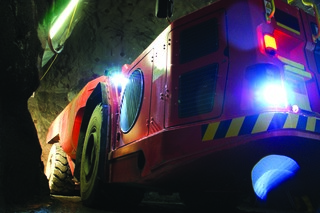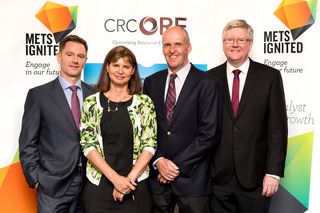Denial, anger, bargaining, depression and acceptance. Those are the five stages of grief.
For mining it is cutting staff, cutting other costs and then, finally when there is nothing left to cut, comes the look for a better way of doing things.
That is where a lot of miners seem to be at the moment and that means hopefully brighter days ahead for the METS players.
Within that sector are a couple of key organisations that are trying to help those METS players make the most of their opportunities.
One of the problems facing many METS players, particularly those in the start-up phase, is getting the message across to miners that what you have can help them save money.
That is where the likes of METS Ignited and the Cooperative Research Centre Optimising Resource Extraction come in. Better yet, the two are joining forces to boost the outcomes for METS players.
Obviously, METS Ignited CEO Dan Sullivan has global domination for the Australian METS sector at the top of his list.
Another is identifying exactly who is who in the METS zoo and what they can do.
METS Ignited is one of six growth centres created as part of the federal government’s productivity agenda.
Those centres are focused on advanced manufacturing; cyber security; food and agribusiness; medical technologies and pharmaceuticals; oil, gas and energy resources; and METS.
The centre is a departure from the traditional Australian industry policy that focused on propping up some industries with subsidies. Australia’s automotive industry was a classic example.
While the federal government picked the sectors for its growth centres, what happens within them is really up to the industries they were formed to support.
The first task facing Sullivan is to develop a 10-year Sector Competitiveness Plan, which will form the blueprint for the sector. The plan is to be updated each year, with the inaugural version due by July.
The plan has to take into account the existing capacity of the industry and where it should ideally be.
Sullivan also wants the industry to have a sense of ownership of the plan and will soon be kicking off some national consultations on it.
A couple of obvious emerging trends in the sector are automation and data collection.
“What does that mean for the Australian industry?” Sullivan postulated.
“We believe where there is a fundamental shift there is an opportunity for Australia to be leading the change.”

Australia already has a fairly good name in the METS game. It could always be better and it is certainly not considered world leading – yet.
Some of the planning work has already been done for METS Ignited. Previous consultations identified issues such as regulation reform, improving management expertise and improving collaboration and commercial outcomes. These are areas the government wants all the growth centres to look at.
“We’ve also identified access to capital, outlining progress to a shared vision and developing a strong global brand for the Australian METS industry [as issues],” Sullivan said.
“One of the biggest barriers for METS companies is getting access to decision makers and being able to prove that what they have will have enormous benefit to the bottom line.
“Miners are very focused on the risk in undertaking something new.”
Implementing new technologies can be a massive challenge.
“How do we de-risk that implementation?” Sullivan asked.
One solution is test mine sites. These have proved their worth in North America and Europe.
Virtual mine sites is another thing METS Ignited is looking at. This is where the data from a real mine is collected and used to model the impact of a potential solution.
This is similar to something the CRC ORE has already developed with its Integrated Extraction Simulator.
By using test mines or virtual mines, METS players can determine not only whether their solution works, but also the net present value it will bring to a mine.
“Those two things together, one looking at technological risk and the other at the financial impact, they’re quite powerful,” Sullivan said.
Another challenge is to find out who is doing what in the METS world.
One of METS Ignited’s mandates is to improve collaboration. Knowing who is doing what and what they are capable of is a crucial part of that.
It will also help identify key research that would otherwise be ignored.
The growth centre has also been asked to review federal government funding and grants.
“We will also be mapping the research capability, [and look at] what’s going on in the METS sector,” Sullivan said.
“It’s not easy thing to find who’s researching what or what METS companies are doing. There is no single source of data on what METS companies are doing or what their capabilities are.

“A lot of the research that gets done just sits on shelves or gets bought out by large multinationals,” Sullivan said.
“METS companies are not even aware this research is happening.”
Indeed, Sullivan would like to be in a position where he could form teams of METS companies to come together to deal with a specific mining problem and make use of some of this forgotten research.
Another issue Sullivan needs to tackle is how METS players can get funding.
“There is a real problem in early stage capital for the METS industry,” he said.
Part of this is due to skill lacks within the METS players themselves. The founders of these companies are usually very engineering focused – it is the nature of what they are doing after all.
“One of the areas we’ll be looking at is management expertise,” Sullivan said.
A large part of that focus will be on developing the capabilities of existing management.
Then there is the issue of where these companies are in their lifecycle.
“A lot of the companies are owned by baby boomers,” Sullivan said.
“It’s an interesting demographic. There are a lot of smaller, family owned METS companies and the owners are looking to retire.
“Where do these companies go? Where does that expertise go?”
There are some really good opportunities for Australia’s METS players but to capitalise on them they have to go global. Of course, with such a step up, come big risks.
“Australia has a lot of very small METS companies,” Sullivan said.
“They are very good in a very tight niche. They have to go global. That is inherently quite risky for small businesses.
“I saw that a lot in Chile with small companies trying to access America. They had to virtually sell to each minesite.”
This leads to some questions about how big METS players want to become.
“Where do we want the industry to be?” Sullivan asked.
“Do we want to be mid-tier? Do we aspire to be top operators?”
Growing businesses – and to be fair some of Australia’s METS players are already mid-tier and beyond – will require not only capital but skills.
“We do think developing their marketing and sales development skills a key one,” Sullivan said.
“That, and globalisation.”
Again it is back to the plan.
Sullivan hopes to get a much better idea of where METS Ignited can have the best impact and believes some of that could be in helping businesses develop their skills.
“There has already been some very interesting work done with the KPMG Energise project,” he said.
One of the focuses of Energise was the provision of mentors to the companies chosen to take part.
“That’s been a very successful program and we’re looking at how we can scale that out and improve it.”
The Department of Industry Innovation and Science has its Enterprise Program that has eight business advisors who are purely focused on the METS space. Those advisors are run out of Austmine.
Picking the right targets will also be crucial to the industry going forward.

“With global supply chains we want to be more judicious about what countries best suit them,” Sullivan said.
“Australian METS companies are not the cheapest around. They are better on value though.”
To succeed means cutting through the procurement process, which is pretty much the mortal enemy of innovation.
“If we can do some smart assessments of the markets and projects we can help guide the companies better,” Sullivan said.
Another issue is the way METS players approach the business.
“A lot of these companies look at themselves as product based companies but they need to be service based,” Sullivan said.
He cites some interesting ways this could happen, holding up what Rolls-Royce is doing with its aircraft engines.
“They get paid by flight hours,” Sullivan said.
“They own that engine and all the data analytics.”
Perhaps there is something in that model for Australian METS players.
“We think Australia has an advantage in that contextual level in big data,” Sullivan said.
“We can be break it down for the operators.”
Sullivan reckons big data is an area an Australian technological major such as a Telstra could become involved in.
“But ultimately we have to be realistic about what Australia can do,” he said.
“It is time for balanced thinking now.”
So does that mean Australia just plays in the ancillary end of the market and leave the big equipment to the established players?
Well there is that large automotive manufacturing sector that is about to be put out of work and, as Sullivan points out, it has had a lot of the costs cut out of it.
Indeed, so too has the mining industry.
“Everything has been cut to the bone,” Sullivan said.
“The next stage has to be innovation.
“We really should be the innovation hub for mining. That ground is yet to be taken, particularly if the shift towards new ways of looking at mining continues.
“Put research together with METS companies and mining companies. There are global mining companies year.
“All the pieces of the puzzle are there, they’re just not connected. That is the challenge for METS Ignited.
“We’ll ideally be able to put together teams in Australia to deal with problems overseas.
“We see the METS sector as a knowledge-rich, export-centred by-product of the mining industry.
“What Australia should invest in and give it more attention.”
The CRC ORE has come from the view that costs are rising while orebodies are getting poorer.

According to CRC ORE CEO Professor Ben Adair, the problem has been miners chasing quantity rather than quality, which has led the cost chickens to come home to roost.
Sadly, that is one group of chickens the industry probably hoped had never hatched in the first place.
Another truism of the mining industry is that ore head grades are falling.
Adair said the copper head grade was going to halve.
“If there are no technological innovations of mining or treating then we will need twice the energy to produce the same amount of metal we are producing right now,” Adair said.
Considering many copper operations where the operators have discarded 30% to 40% of the resource as mineralised waste because its grade is too low and there seems to be an almost immediate answer right there.
Finding the sort of innovations that are going to minimise waste and reduce the amount of energy needed to produce metal are very much the CRC ORE’s remit.
CRC ORE started in 2010 and was recently awarded another six-year term taking it through to 2021.
The government is putting up about $34 million for the CRC and industry support is about double that taking its funding for the six years to more than $100 million.
Of course there is no such thing as a free lunch. There is a whole suite of deliverables expected from this six-year term.
Adair said the CRC’s second term remit was quite different to its first.
“The first six was effectively to build a consensus and develop technology in conjunction with mining companies and targeted research organisations,” he said.
Two significant technologies came out of that first term, a grade engineering technology, called Grade Engineering and a new way of upgrading and rejecting material before it gets into process plants called the Integrated Extraction Simulator.
“That technology [Grade Engineering] is being adopted and implemented at several major mining sites across the world,” Adair said.
He said the IES was a new architecture in enterprise modelling across the value chain.
“It puts attributes into the model and determines what you would get from different parts of the orebody,” Adair said.
One of the aims of CRC ORE is to bring together miners, suppliers and targeted research organisations.
“We have to foster some serious step change innovation,” Adair said.
“We have to integrate it across different parts of the value chain. We will be judged on how quickly we innovate or fast track this onto various sites."
“In the current product development model for supply the time period is quite long. The risk is carried by the supplier.
“Our role is to broker, foster and develop innovations and technology and get them implemented.”
This is not just focused on the technology developers. Adair believes the users of that technology are also critical components of the CRC.
“I think the model we have brings together these very disparate groups,” he said.
“The heart and soul of the CRC will be our implementation council.”
That council will have representatives from each of the mining companies participating in the CRC as well as the research organisations and supply companies.
The mining companies involved with CRC ORE are Anglo American, BHP Billiton, Newcrest, Glencore, Sumitomo and Teck.
Adair said the mining industry was mostly made up of early adopters and fast followers.
“What we have in our mix is a group of companies looking to improve things on their sites right now,” he said.
The research organisations are AMIRA, CRC Mining, CSIRO, Curtin University, the Minerals Research Institute of Western Australia, the National Research Council Canada, the Queensland University of Technology, the University of Adelaide, the University of Queensland and the University of Tasmania.
On the METS side the players are Hatch, Imdex, JKTech, METS Ignited, Orica, Sedgman, Schlumberger and Sodern.
“Let’s assume one or two of our research organisations produced something special,” Adair said.
“The mining companies think it has merit.
“The only one that can implement it and scale it are the supply companies themselves.
“Our model is that these innovations be implemented at various sites. Ultimately it is the supply companies that can tech-transfer it.
“Certainly the mining companies will have to get a competitive advantage out of it.”

























